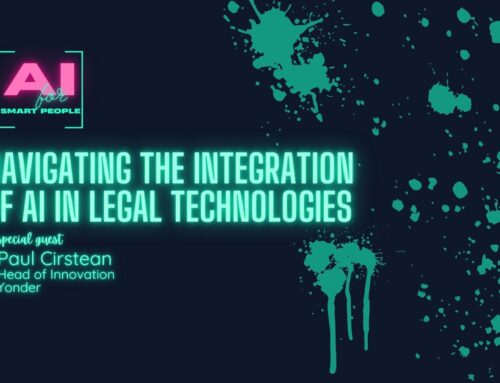Beyond Algorithms: eDiscovery’s AI Evolution with Cat Casey
In a recent episode of the “AI for Smart People” podcast, the discussion centered around the integration of AI beyond just algorithms, focusing on practical applications and implications in the legal industry. Featuring Cat Casey, Chief Growth Officer at Reveal, the episode provided valuable insights into how AI is transforming legal workflows and the broader implications for legal professionals. Here are the key takeaways.
The Evolution of eDiscovery with AI
Cat Casey, with her extensive background in eDiscovery, shared her journey and insights into how AI has been gradually integrated into legal practices. She explained that technologies like predictive coding, email threading, and sentiment analysis have been part of legal workflows for years. These tools, often not recognized as AI, have streamlined document review and data management processes, making legal work more efficient.
Cat emphasized that the recent surge in generative AI has brought a renewed focus on AI’s capabilities. This new wave of AI can create new content and provide more advanced data insights, representing a significant shift from traditional AI applications. The challenge now is to leverage these advanced tools while maintaining accuracy and reliability in legal processes.
Practical AI Applications in Legal Workflows
One of the significant points discussed was how AI can be used to enhance existing legal tools rather than replacing them. For example, Cat highlighted the use of generative AI to ask broad questions and identify key documents, which can then be further analyzed using established tools like sentiment analysis and communication mapping. This layered approach allows legal professionals to start with broad queries and narrow down to specific, actionable insights.
Cat provided an example from her experience where AI was used to identify potential risk areas in a large dataset. By applying AI to sift through sentiment analysis and concept clustering, she was able to narrow down the focus to a few critical interactions, saving time and resources in the process. This method of using AI as a pointer to guide deeper investigation is becoming increasingly valuable in legal practice.
Insights on AI Integration
Cheryl Wilson Griffin underscored the importance of AI in modernizing legal practices. She reflected on the initial skepticism surrounding AI, especially with technologies like TAR 1.0. Cheryl highlighted how far AI has come and emphasized the potential for AI to revolutionize the legal industry further. She noted that integrating AI into legal workflows can significantly enhance efficiency and accuracy, enabling legal professionals to focus on more strategic tasks.
The Importance of Human Oversight
While AI can significantly enhance legal workflows, Cat stressed the importance of keeping humans in the loop. She noted that AI should be seen as a tool that aids human decision-making rather than replacing it. Human expertise is crucial in interpreting AI-generated insights, validating results, and making strategic decisions based on those insights.
Cat used the metaphor of AI as an Iron Man suit for legal professionals – it enhances capabilities but requires a human to operate effectively. This approach ensures that AI remains a tool for augmentation rather than replacement, preserving the critical role of human judgment in legal processes.
Addressing Ethical and Practical Considerations
The conversation also touched on the ethical and practical considerations of using AI in legal practice. Cat highlighted the need for transparency in how AI tools are developed and used. She emphasized the importance of understanding the underlying models and ensuring that AI outputs are accurate and unbiased. This includes being aware of potential risks like bias in training data and the need for thorough validation of AI-generated insights.
Preparing for the Future of AI in Legal Practice
Looking ahead, Cat and Cheryl encouraged legal professionals to stay informed about AI developments and actively engage with new technologies. They suggested forming AI committees within law firms to assess and integrate AI tools effectively. This proactive approach will help firms stay competitive and leverage AI’s full potential while managing risks.
Cat also pointed out the importance of building partnerships with tech companies and participating in industry discussions to shape the future of AI in legal practice. By staying engaged and informed, legal professionals can ensure they are well-prepared for the evolving landscape of AI technology.
Conclusion
The “AI for Smart People” podcast episode with Cat Casey and insights from Cheryl Wilson Griffin provided a comprehensive overview of how AI is being integrated into legal workflows beyond just algorithms. By leveraging AI to enhance existing tools, maintaining human oversight, and addressing ethical considerations, legal professionals can harness the power of AI to improve efficiency and accuracy in their work. This episode underscores the transformative potential of AI in legal practice and the importance of staying proactive in its adoption.
4o



